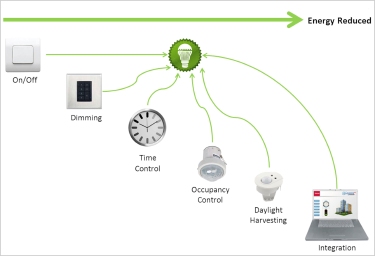Lighting efficiency versus luminaire efficiency

With Part L regulations taking effect in April, many want to know the most efficient way to be compliant. Dan Wills of Helvar talks us through the methods of calculating compliancy with Part L and the role that lighting control will play.
From the first automatic thyristor dimmers in the 1960s to today’s fully programmable systems, the technology used for lighting control has been available to deliver an efficient, functional and aesthetically pleasing lighting design to suit any application. However, considering that on average lighting accounts for 35% of a building’s energy usage, little scope has been given to lighting controls in legislation — until now.
From April this year, the long-awaited changes to Part L of the Building Regulations come into force. Under the revisions, new-build homes will have to be 6% more efficient than under previous regulations. The aggregate figure for non-domestic buildings is 9%.
The new regulations require a significant increase in lighting efficiency, and lighting controls will play a key role in achieving this. There are two calculation methods put forward to help building managers reach the targets set.
Luminaire Efficacy Method, in which you must achieve 60 lumens per circuit watt or the Lighting Energy Numeric Indicator (LENI) method, which calculates predicted energy use rather than the efficiency of the luminaires.
With minimum luminaire efficacy set to increase from 55 to 60 lm/W (circuit), considerable constraints will be in place when specifying the type of luminaires to be used. However, more comprehensive lighting-control factors can now be considered, allowing better use of energy-efficient luminaires and achieving a higher-quality visual environment. Using a lighting-control package makes it possible to achieve up to 30% reduction on the original luminaire efficacy, which in turn will allow designers to achieve both better energy efficiency and the desired visual environment.
The standard control factors for the Luminaire Efficacy Method (LEM) are as follows.
• Daylight controls, with or without dimming.
• Automatic on/off occupancy control.
• Manual on, with automatic off via occupancy control.
• Dimmed for constant luminance; there is no allowance for using daylight as a principal light source in LEM.
By using daylight harvesting, you can offset the amount of lighting required to properly light a space, therefore reducing energy consumption. The best control factor can be achieved with daylight harvesting (with dimming) and absence detection (manual on/auto off).
LENI has been introduced as an alternative calculation method. Previously, LENI had been seen as too complicated. However, new simplified formulas and software have been created to make it a much easier method to understand and calculate. Monitoring the energy used by lighting over the course of a year and dividing that figure by the areas being lit means that LENI promotes the efficient use of light, not just the efficiency of individual lighting components.

Using the LENI method, desired lighting effects can be achieved using a range of luminaire types, provided the design as a whole comes within LENI allowances. Compliance with Part L can be calculated at the design stage and then measured in the live building, which also benefits the building owner as the basis for on-going energy improvements.
The applicable control factors and constant luminance factor can be applied based on proposed zone usage. This enables better freedom of choice for designers and specifiers alike as they can select a variety of both efficient and non-efficient luminaires.
There are three key control factors for LENI.
• Occupancy factor (Fo) — how often the space is likely to be empty.
• Factor for daylight (Fd) — how much daylight is available in the space.
• Constant luminance factor (Fc) — How the lighting control system reduces the energy used when full power is not required.
By taking into account the ways that lighting is being used, as opposed to the energy being used by the luminaires while they are switched on, it can be said that this is a much more efficient approach than simply specifying high-efficacy lights.
The efficiency of a light becomes irrelevant if kept on continuously. It will still consume much more energy than a light that is controlled and only used when it is needed.
Intelligent lighting-control solutions are set to play a major role in homes and buildings of the future as the continuing drive to zero carbon gathers pace. New technologies in lighting, such as LED, have had huge media exposure over the past few years. Although it is clear luminaire efficacy is greatly improved when using LEDs, it is the use of LED luminaires which will define its effectiveness over its stated lifetime. This is why lighting controls are required. As LED luminaires are set to grow exponentially over the coming years, we will see the same growth in complementary lighting controls. End-to-end lighting solutions are in high demand as it guarantees compliancy with Part L.
The LENI approach can also be used to further benchmark a building’s energy consumption as the method also takes into consideration controls for example, HVAC. With the range of software tools now available to make the calculations for you, it has never been easier to ensure you reach an overall level of compliancy.
Dan Wills is LED specification sales engineer at Helvar.







